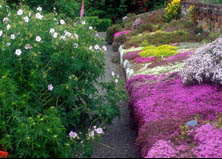Companion planting: growing runner beans with pot marigolds
 I can't help it but I have to mention the weather yet again! We've had all August's rainfall in the first two weeks of the month; the lawns are witness to this, growing more lushly and needing quicker cutting than I can ever remember. But despite all that, the garden looks wonderful, dreamy and hazy with golden seedheads on tall grasses, massed beds of Verbena bonariensis and swathes of perennials that are never staked but, being densely planted, have held each other up throughout it all. And there have been no outbreaks of pests or if there have, the natural balance of the garden has been able to compensate - blue tits speedily picking aphids from branches, ladybirds and hover fly larvae doing their bit in flower heads and thrushes pulverising snails on the brickwork!
I can't help it but I have to mention the weather yet again! We've had all August's rainfall in the first two weeks of the month; the lawns are witness to this, growing more lushly and needing quicker cutting than I can ever remember. But despite all that, the garden looks wonderful, dreamy and hazy with golden seedheads on tall grasses, massed beds of Verbena bonariensis and swathes of perennials that are never staked but, being densely planted, have held each other up throughout it all. And there have been no outbreaks of pests or if there have, the natural balance of the garden has been able to compensate - blue tits speedily picking aphids from branches, ladybirds and hover fly larvae doing their bit in flower heads and thrushes pulverising snails on the brickwork!
One of the ways that we encourage this balance is by planting a wide range of different herbs and perennials, mixing plants up and allowing self-seeding or in the case of the vegetable garden, companion planting with pot marigolds. These vibrant double flowers, Calendula officinalis 'Orange King' were favourites of Gertrude Jekyll and I love their cheerful, bright Indian colours. Here you can see them grown in front of the runner beans which we are now harvesting - how delicious freshly picked runner beans are! We are growing a variety called 'Painted Lady' for its pretty bicoloured flowers in red and white, good enough to grow in a front garden. There's so much to notice that is out in flower right now despite the fact that August is a difficult time to keep the garden looking dynamic. One of the hardest working plants I can think of is this low-growing Persicaria affine which spreads in flat mats across the paving slabs and breaks up the line of the gravel path. It's flowers just keep on and on, changing colour as they mature from palest pink, through deep pink to a swathy red. This means that you have all these colours at once on its spreading mass, and its attractive leaves will start to colour up too when the autumn comes. Our gravel paths are made from whinstone from a local quarry just three miles away - whinstone is what forms the rocky outcrops along which Hadrian's Wall loops and twists in much photographed undulations. The grey gravel is such a good foil for so many garden plants and hasn't had lots of miles to travel either!
There's so much to notice that is out in flower right now despite the fact that August is a difficult time to keep the garden looking dynamic. One of the hardest working plants I can think of is this low-growing Persicaria affine which spreads in flat mats across the paving slabs and breaks up the line of the gravel path. It's flowers just keep on and on, changing colour as they mature from palest pink, through deep pink to a swathy red. This means that you have all these colours at once on its spreading mass, and its attractive leaves will start to colour up too when the autumn comes. Our gravel paths are made from whinstone from a local quarry just three miles away - whinstone is what forms the rocky outcrops along which Hadrian's Wall loops and twists in much photographed undulations. The grey gravel is such a good foil for so many garden plants and hasn't had lots of miles to travel either!



